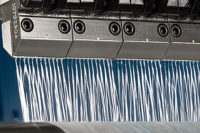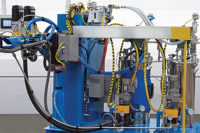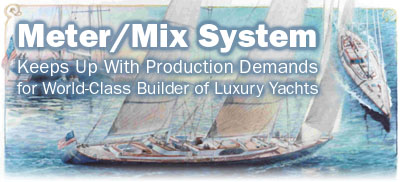
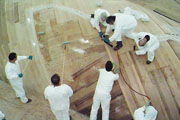
Having taken over the business from his father “Sonny,” where the time-honored method of fastening planks on frames was still being practiced, Hodgdon knew that to compete in an increasingly high-tech market, it would be critical to research and implement the latest technologies and processes into the design and construction of his yachts. That research led to the use of cold molding, a process that uses epoxy to bond a successive series of thin wood laminates to a wood frame, providing an extremely strong and stable hull.

Following the application of each laminate series, the strips are further held in place to achieve full bond strength by using a unique but simple method known as vacuum bagging in which large sheets of plastic bubble wrap are laid over the wood and sealed around the perimeter. A vacuum pump is connected to the plastic “tent” and the resident air removed, yielding an even clamping force over the entire surface.

For these reasons, Hodgdon turned to Sheepscot Machine Works, a manufacturer of meter/mix and dispense systems, to provide a solution to these issues. Todd Williams, sales manager for Sheepscot and also a neighbor and friend, consulted with Hodgdon on the best type and size of equipment, as well as the optimal configuration for use in a boatyard environment. They chose the Model 9450 Double Acting System, which would provide continuous fluid output, a critical feature for satisfying the large-output demand. With pneumatic supply pumps and using a low-viscosity epoxy supplied by Gougeon Brothers of Bay City, Mich., Sheepscot determined that the Model 9450 could deliver upwards of one gallon per minute of mixed material, more than adequate to keep up with production demands. A cart-mounted configuration with casters was chosen to provide maximum mobility, allowing the meter/mix and its associated drum feed to be moved throughout the building, depending on where the planking was taking place, or to be moved between the two buildings that were being used for various gluing tasks.
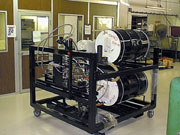
Now that the hull has been molded and turned upright, work will start on a multitude of other projects, including epoxy saturation of carbon fiber sheets used in the fabrication of deck tops and interior partitions. Wherever medium to large quantities of adhesive are called for, the 9450 system will be put to use.
Launch date for the Scheherazade is 2003.
For more information on Hodgdon Yachts and Scheherazade, visit the Web site www.hodgdonyachts.com.
For more information on Sheepscot Machine Works, call Todd Williams at 207-563-2299 or visit the Web site www.sheepscotmachine.com. Or Circle No. 202.
Additional information on the ProSet series of low-viscosity epoxies is available from Gougeon Brothers, PO Box 908, Bay City, MI 48707-0908; call 989-684-7286; fax 989-684-1287; e-mail tpp@gougeon.com; or visit the Web site www.gougeon.com. Or Circle No. 203
